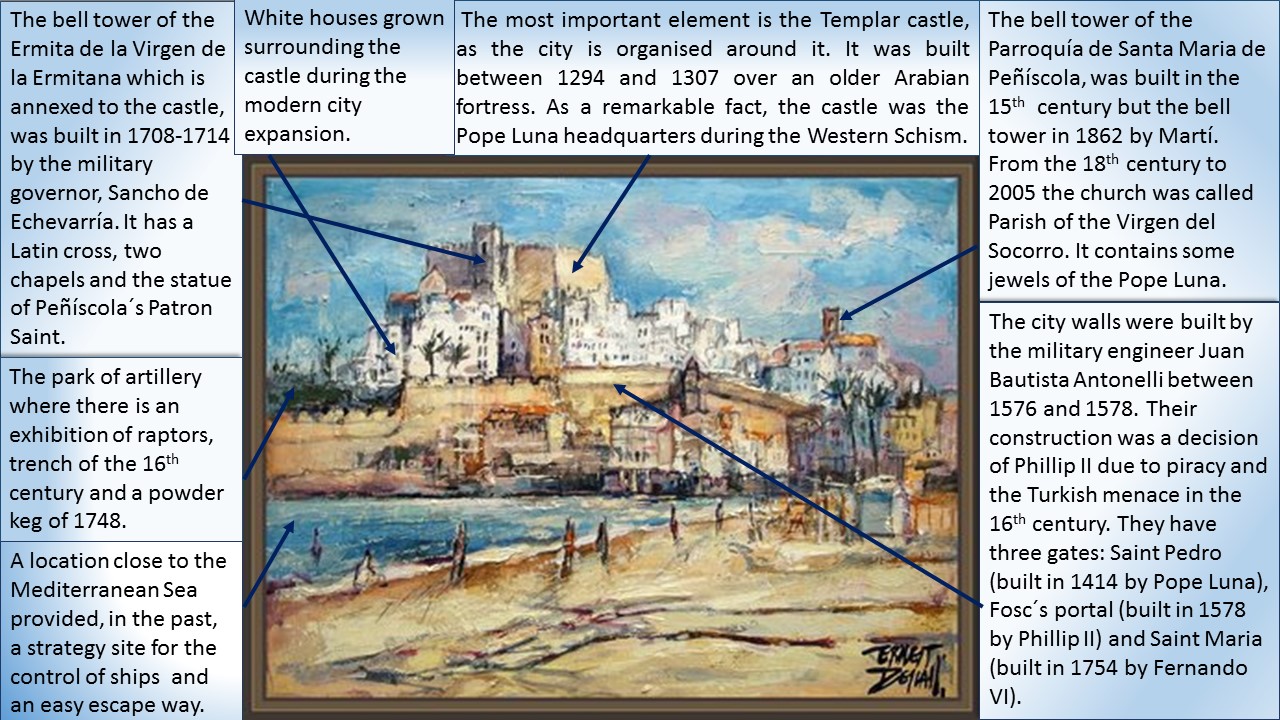This work of art was painted by the artist Ernest Descals, whose signature is placed in the bottom right hand corner. It is an oil on canvas painted in 2008 of Peñíscola (Castellón, Community of Valencia, Spain). At the beginning, Peñíscola was named by the Greeks in the 4th century AD as a translation of the word “península”. Later, the Latin speakers named it “pene+iscola” which translates approximately as “almost island”. Finally, we have Peñíscola in Castilian.
Peñíscola was named a city by King Felipe V in 1709, with this words “Muy Noble, Leal y Fidelísima Ciudad”, thanks to the support given to him in the War of Spanish Succession. The town was declared an historical and cultural site in 1972. It is a place with more than 2,500 years of history. Here, Iberians, Phoenicians, Greeks, Romans, Carthaginians, Arabians and Christians have settled because of its great location in the map of Spain.
Among the urban features, the Templar castle was declared an historical and artistic national monument in 1931. The style of art is situated between roman and gothic. Moreover, the fortress takes up the most elevated zone of the city with an average height of 20 metres, 64 metres above the sea level and 230 metres perimeter. But nowadays only three or fourth parts exist because in the War of Independence, in 1814, General Elio tried to recover the city which had been previously conquered by the French. Therefore, we can observe that its best characteristic is its strongly fortified defenses. A remarkable fact was the stay of Pope Benedict XIII, Pope Luna or Pedro Martínez de Luna, who made it a Pope castle in 1415-1423. The castle has always been occupied by noblemen. Interestingly, this castle is the second most visited monument in Spain, after the Alhambra of Granada. Inside, we can find a church, a library, the stables, pontificate rooms, the meeting room of the conclave, the gothic meeting room of the commander, the dungeons… As a consequence of the Pope castle and the two churches mentioned in the image, that we find in the reduced space of the old quarter, we can deduce that the religion, at least in the past, had a great importance.
In the image we can appreciate the North beach of the city and the housing surrounded by city walls with the old medieval quarter. The Templar castle is at the top with an irregular planning town. It is so important because it is the origin of the city. Then, we find a group of white houses. They are very narrow, tall and surround the castle, forming the “village”. This is where general population and the bourgeoisie lived. The long, narrow, parallel and perpendicular, sloping streets provided defence in case of enemy attacks. Moreover, this houses served as a supplement and support for the castle because there form the modern city expansion, with regular houses resulting in a grid system. All of it is protected by the city walls, the boundary. Later, in 1960, with tourism the city continued to develop and houses outside the walls began to appear. They were near to the beach with a long boardwalk and some hotels, forming the residential periphery. Then, in the outskirts there are some industries, houses, urbanizations and a lot of land without houses because there is a lot of protected space and likewise due to the agrarian activity.
Peñíscola is in a very good location due to the proximity to the sea. The old quarter is nearly completely surrounded by water, from where the population could escape easily, while having a fishing and sea trade. Also the whole city is surrounded by cliffs (a great characteristic of its defence), beaches, fountainheads and rivers (one of which is an underground river). Furthermore, here we find the Natural Park of the Irta Mountains with a height of 573 metres and a longitude of 15 kilometres and the Marjal, both of which are very significant.
In addition, Peñíscola´s port has always been an important infraestructure for trade. Therefore, there is a Sea museum where we can learn about the history, fauna and fishing. It was the exchanging point of Peñíscola´s wine and olive oil for manufactured products such as factory and arms that arrived at the port. Apart from the sea trade, agriculture has always been an important factor for economic development and business. Wine, Carob, Olive tree and Almond tree were and still are the most cultivated plants.
To conclude, we should mention that in 1890 Peñíscola lost its military relevance due to the arsenal being moved to Cartagena. That led to the beginning of tourism and a significant economic activity. At final, emphasize with the most important function of Peñíscola, which served for controlling the sea and it had and has an important port for Spain.
Olga B. Celda Alonso

